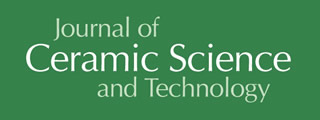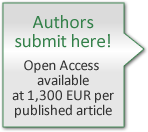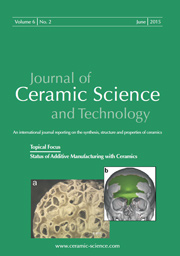Articles
All articles | Recent articles
Influence of Material and Processing Parameters on the Surface Roughness of Injection-Molded Ceramic Parts
S. Greiner1, K. Kurth1, C. Fix2, T. Braun3, J. Franke3, D. Drummer1
1 Institute of Polymer Technology, Friedrich-Alexander-University (FAU) Erlangen-Nürnberg
2
3 Institute for Factory Automation and Production Systems, Friedrich-Alexander-University (FAU) Erlangen-Nürnberg
received Febuary 9, 2017, received in revised form Febuary 17, 2017, accepted March 16, 2017
Vol. 8, No. 2, Pages 277-286 DOI: 10.4416/JCST2017-00009
Abstract
Ceramic parts were prepared by means of injection molding and a two-step debinding and sintering process. For four different alumina ceramic feedstocks, the influence of processing parameters like holding pressure, injection speed, melt and mold temperature on the surface roughness was studied. The surface roughness was measured in the direction of flow and perpendicular to it with a tactile cantilever measuring system. A gradient in the surface roughness is detected along the flow path, which ended in a relatively coarse surface section. Smoother and more even surface structures can be generated with higher mold temperatures. In general, larger particle diameters cause greater surface roughness. Lower injection speed and melt temperature show similar effects. However, no significant effect was observed with regard to the holding pressure. Based on these results, the surface roughness could be adjusted in a certain range by changing material or processing parameters in order to fulfill the requirements of a subsequent metallization step.
![]() Download Full Article (PDF)
Download Full Article (PDF)
Keywords
Ceramic injection molding, surface roughness, ceramic feedstock, Al2O3 ceramics
References
1 German, R.M., Bose, A.: Injection molding of metals and ceramics. Metal Powder Industries Federation, Princeton, 1997.
2 Reed, J.S.: Principles of ceramics processing. Wiley, New York, 1995.
3 Zhang, T., Blackburn, S., Bridgwater, J.: Debinding and sintering defects from particle orientation in ceramic injection molding, J. Mater. Sci., 31, 5891 – 5896, (1996).
4 Liu, L., Loh, N.H., Tay, B.Y., Tor, S.B., Murakoshi, Y., Maeda, R.: Effects of thermal debinding on surface roughness in micro powder injection molding, Mater. Lett., 61, 809 – 812, (2007).
5 Trunec, M., Cihlar, J.: Thermal debinding of injection molded ceramics, J. Eur. Ceram. Soc., 17, 203 – 209, (1997).
6 Trunec, M., Cihlar, J.: Thermal removal of multicomponent binder from ceramic injection mouldings, J. Eur. Ceram. Soc., 22, 2231 – 2241, (2002).
7 Xie, Z.P., Wang, L.L., Yang, X.F.: Study of water-debinding for ceramic parts by injection molding, Mater. Sci. Forum, 561 – 565, (2007).
8 Liu, D.-M., Tseng, W.J.: Influence of debinding rate, solid loading and binder formulation on the green microstructure and sintering behaviour of ceramic injection mouldings, Ceram. Int., 24, 471 – 481, (1998).
9 Shivashankar, T.S., German, R.M.: Effective length scale for predicting solvent-debinding times of components produced by powder injection molding, J. Am. Ceram. Soc., 82, 1146 – 1152, (1999).
10 Liu, D.-M., Tseng, W.J.: Binder removal from injection moulded zirconia ceramics, Ceram. Int., 25, 529 – 534, (1999).
11 Benzler, T.: Powder injection molding in microtechnology, dissertation in German, Freiburg, Universität Freiburg, Forschungszentrum Karlsruhe, 2001.
12 Franke, J.: Three-dimensional molded interconnect devices (3D-MID): Materials, manufacturing, assembly and application for injection molded circuit carriers, in German, Hanser Verlag, Munich, 2013.
13 Franke, J., Gausemeier, J., Goth, C., Dumitrescu, R.: MID-Study 2011-market and technology analysis. A study on behalf of the Forschungsvereinigung Räumliche Elektronische Baugruppen 3-D MID e. V., in German, Erlangen, 2011.
14 Komarov, S.V., Romankov, S.E.: Mechanical metallization of alumina substrate through shot impact treatment, J. Eur. Ceram. Soc., 34, 391 – 399, (2014).
15 Xin, C., Liu, W., Li, N., Yan, J., Shi, S.: Metallization of Al2O3 ceramic by magnetron sputtering Ti/Mo bilayer thin films for robust brazing to kovar alloy, Ceram. Int., 42, 9599 – 9604, (2016).
16 Hwang, H.R., Lee, R.Y.: The effects of metal coating on the diffusion bonding in Al2O3/Inconel 600 and the modulus of rupture strength of alumina, J. Mater. Sci., 31, 2429 – 2435, (1996).
17 Choa, B.-R., Leea, J.-J., Kang, S.-K.: Effect of composition change on sintering and metallizing of alumina ceramics, J. Ceram. Process. Res., 10, 121 – 123, (2009).
18 Zheng, Z., Zhang, Y., Yi, F., Chen, C., Song, X.: Surface metallization of alumina ceramics: effects of sintering time and substrate etching, Ceram. Int., 40, 12709 – 12715, (2014).
19 Rong, C., Zhang, J., Liu, C., Yang, S.: Surface metallization of alumina ceramics by pulsed high energy density plasma process, Appl. Surf. Sci., 200, 104 – 110, (2002).
20 Bulasara, V.K., Chandrashekar, O., Uppaluri, R.: Effect of surface roughness and mass transfer enhancement on the performance characteristics of nickel-hypophosphite electroless plating baths for metal-ceramic composite membrane fabrication, Chem. Eng. Res. Des., 89, 2485 – 2494, (2011).
21 Forschungsvereinigung räumliche elektronische Baugruppen 3-D MID e. V.: 3D-MID technology: Spatial electronic assemblies: Manufacturing process, performance requirements, material properties, in German, Carl Hanser Verlag, Munich, 2004.
22 Zhang, K.F., Lu, Z.: Surface features of polymer and ceramic microstructured parts manufactured by micro injection molding, Symposium on Design, Test, Integration and Packaging of MEMS/MOEMS, 212 – 217, 1999.
23 Nickel, S.: Analysis of the ceramic injection molding process, dissertation in German, Erlangen-Tennenlohe: Lehrstuhl für Kunststofftechnik, 1998.
24 Islam, A., Giannekas, N., Marhöfer, D.M., Tosello, G., Hansen, H.N.: Experimental investigation on shrinkage and surface replication of injection moulded ceramic parts, Proceedings of the 4th International Conference on Nanomanufacturing (nanoMan2014), 2014.
25 Braun, T., Greiner, S., Franke, J., Drummer, D.: Additive plasma metallization of spatial ceramic injection molded components, 12th International Congress Molded Interconnect Devices, 62 – 67, 2016.
Copyright
Göller Verlag GmbH


